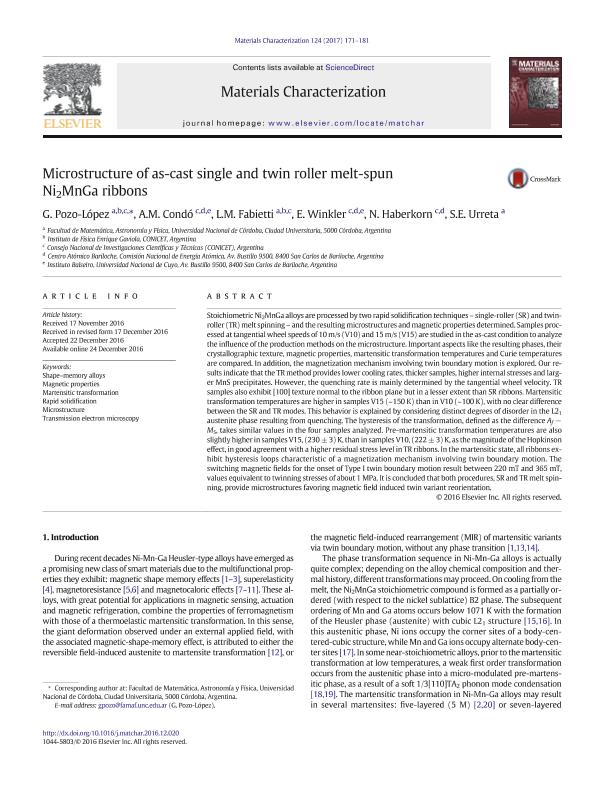Artículo
Microstructure of as-cast single and twin roller melt-spun Ni2MnGa ribbons
Pozo Lopez, Gabriela del Valle ; Condo, Adriana Maria
; Condo, Adriana Maria ; Fabietti, Luis Maria Rodolfo
; Fabietti, Luis Maria Rodolfo ; Winkler, Elin Lilian
; Winkler, Elin Lilian ; Haberkorn, Nestor Fabian
; Haberkorn, Nestor Fabian ; Urreta, Silvia Elena
; Urreta, Silvia Elena
 ; Condo, Adriana Maria
; Condo, Adriana Maria ; Fabietti, Luis Maria Rodolfo
; Fabietti, Luis Maria Rodolfo ; Winkler, Elin Lilian
; Winkler, Elin Lilian ; Haberkorn, Nestor Fabian
; Haberkorn, Nestor Fabian ; Urreta, Silvia Elena
; Urreta, Silvia Elena
Fecha de publicación:
02/2017
Editorial:
Elsevier Science Inc
Revista:
Materials Characterization
ISSN:
1044-5803
Idioma:
Inglés
Tipo de recurso:
Artículo publicado
Clasificación temática:
Resumen
Stoichiometric Ni2MnGa alloys are processed by two rapid solidification techniques – single-roller (SR) and twin-roller (TR) melt spinning – and the resulting microstructures and magnetic properties determined. Samples processed at tangential wheel speeds of 10 m/s (V10) and 15 m/s (V15) are studied in the as-cast condition to analyze the influence of the production methods on the microstructure. Important aspects like the resulting phases, their crystallographic texture, magnetic properties, martensitic transformation temperatures and Curie temperatures are compared. In addition, the magnetization mechanism involving twin boundary motion is explored. Our results indicate that the TR method provides lower cooling rates, thicker samples, higher internal stresses and larger MnS precipitates. However, the quenching rate is mainly determined by the tangential wheel velocity. TR samples also exhibit [100] texture normal to the ribbon plane but in a lesser extent than SR ribbons. Martensitic transformation temperatures are higher in samples V15 (~ 150 K) than in V10 (~ 100 K), with no clear difference between the SR and TR modes. This behavior is explained by considering distinct degrees of disorder in the L21 austenite phase resulting from quenching. The hysteresis of the transformation, defined as the difference Af − MS, takes similar values in the four samples analyzed. Pre-martensitic transformation temperatures are also slightly higher in samples V15, (230 ± 3) K, than in samples V10, (222 ± 3) K, as the magnitude of the Hopkinson effect, in good agreement with a higher residual stress level in TR ribbons. In the martensitic state, all ribbons exhibit hysteresis loops characteristic of a magnetization mechanism involving twin boundary motion. The switching magnetic fields for the onset of Type I twin boundary motion result between 220 mT and 365 mT, values equivalent to twinning stresses of about 1 MPa. It is concluded that both procedures, SR and TR melt spinning, provide microstructures favoring magnetic field induced twin variant reorientation.
Archivos asociados
Licencia
Identificadores
Colecciones
Articulos(CCT - PATAGONIA NORTE)
Articulos de CTRO.CIENTIFICO TECNOL.CONICET - PATAGONIA NORTE
Articulos de CTRO.CIENTIFICO TECNOL.CONICET - PATAGONIA NORTE
Articulos(IFEG)
Articulos de INST.DE FISICA ENRIQUE GAVIOLA
Articulos de INST.DE FISICA ENRIQUE GAVIOLA
Citación
Pozo Lopez, Gabriela del Valle; Condo, Adriana Maria; Fabietti, Luis Maria Rodolfo; Winkler, Elin Lilian; Haberkorn, Nestor Fabian; et al.; Microstructure of as-cast single and twin roller melt-spun Ni2MnGa ribbons; Elsevier Science Inc; Materials Characterization; 124; 2-2017; 171-181
Compartir
Altmétricas



